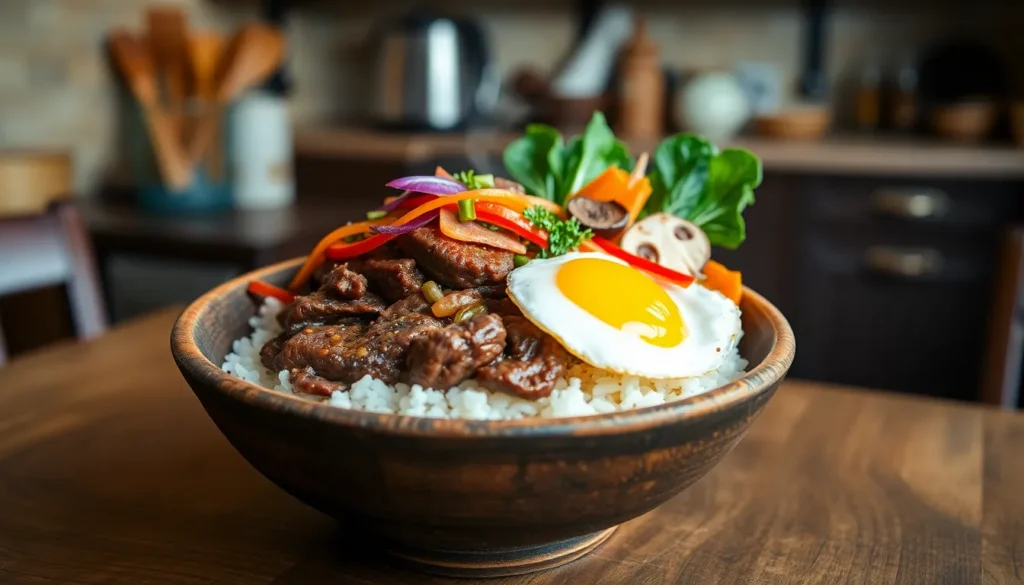We’re about to transform your weeknight dinner routine with this irresistible beef bulgogi bowl recipe that brings authentic Korean flavors straight to your kitchen. This beloved dish features tender marinated beef that’s sweet, savory, and incredibly aromatic – it’s no wonder bulgogi translates to “fire meat” in Korean.
What makes our bulgogi bowl truly special is the perfect balance of flavors in the marinade. We combine soy sauce, brown sugar, sesame oil, and fresh garlic to create that signature taste that’ll have your family asking for seconds. The thinly sliced beef absorbs these flavors beautifully and cooks in just minutes.
Whether you’re craving comfort food or want to impress guests with minimal effort, this bulgogi bowl delivers restaurant-quality results at home. We’ll show you exactly how to achieve that perfect caramelized exterior while keeping the meat incredibly tender inside.
Ingredients
We’ve organized these ingredients into convenient sections that mirror our cooking process. Each component plays a crucial role in building the complex layers of flavor that make this bulgogi bowl irresistible.
For the Bulgogi Marinade
- 1/2 cup soy sauce (low sodium preferred)
- 1/4 cup brown sugar (packed)
- 2 tablespoons sesame oil
- 4 cloves garlic (minced)
- 1 tablespoon fresh ginger (grated)
- 1 medium Asian pear (grated, or substitute with 1 tablespoon honey)
- 2 green onions (finely chopped)
- 1 tablespoon rice wine or mirin
- 1 teaspoon black pepper (freshly ground)
- 1 teaspoon toasted sesame seeds
For the Beef and Bowl Assembly
- 1.5 pounds ribeye steak (thinly sliced against the grain)
- 4 cups cooked short-grain white rice (preferably day-old)
- 2 tablespoons vegetable oil (for cooking)
- 4 large eggs
- 2 cups fresh spinach (blanched and seasoned)
- 1 large carrot (julienned)
- 1 medium zucchini (julienned)
- 8 ounces shiitake mushrooms (sliced)
- 2 tablespoons soy sauce (for vegetables)
- 1 tablespoon sesame oil (for vegetables)
For the Pickled Vegetables
- 1 medium cucumber (thinly sliced)
- 1 medium daikon radish (julienned)
- 2 tablespoons rice vinegar
- 1 tablespoon sugar
- 1 teaspoon salt
- 1/2 teaspoon red pepper flakes
For Serving and Garnish
- 2 tablespoons gochujang (Korean chili paste)
- 2 green onions (sliced diagonally)
- 1 tablespoon toasted sesame seeds
- 1 sheet roasted seaweed (cut into strips)
- 4 lime wedges
- Extra sesame oil for drizzling
Equipment Needed

We need exact kitchen tools to create this authentic beef bulgogi bowl recipe efficiently. The right equipment ensures our beef develops those signature caramelized edges while maintaining tender texture throughout.
Stovetop skillet or frying pan serves as our primary cooking vessel for searing the marinated beef. We recommend using a heavy-bottomed pan that distributes heat evenly and prevents hot spots that could burn our carefully prepared marinade.
Broiler or oven provides an optional finishing method for achieving those coveted charred edges. This equipment allows us to add extra crispiness to our beef without overcooking the interior meat.
Cooking pot or rice cooker handles our grain preparation whether we choose traditional white rice, brown rice, or quinoa as our base. Properly cooked grains provide the foundation that absorbs all the delicious bulgogi flavors.
Mixing bowls become essential for combining our marinade ingredients and preparing various components separately. We use different sized bowls to keep our marinated beef separate from fresh vegetables and garnishes.
Measuring spoons and cups ensure accuracy in our marinade ratios, which directly impacts the final flavor balance. Precise measurements help us achieve that perfect sweet and savory combination every time.
Knife and cutting board handle all our prep work from slicing beef into thin strips to chopping vegetables and mincing aromatics like garlic and ginger. Sharp knives make quick work of preparing uniform pieces that cook evenly.
Whisk or jar with lid combines our marinade ingredients thoroughly, ensuring every component blends completely. A jar with lid offers the advantage of vigorous shaking, which helps emulsify our sesame oil with other liquid ingredients for optimal beef coating.
Instructions
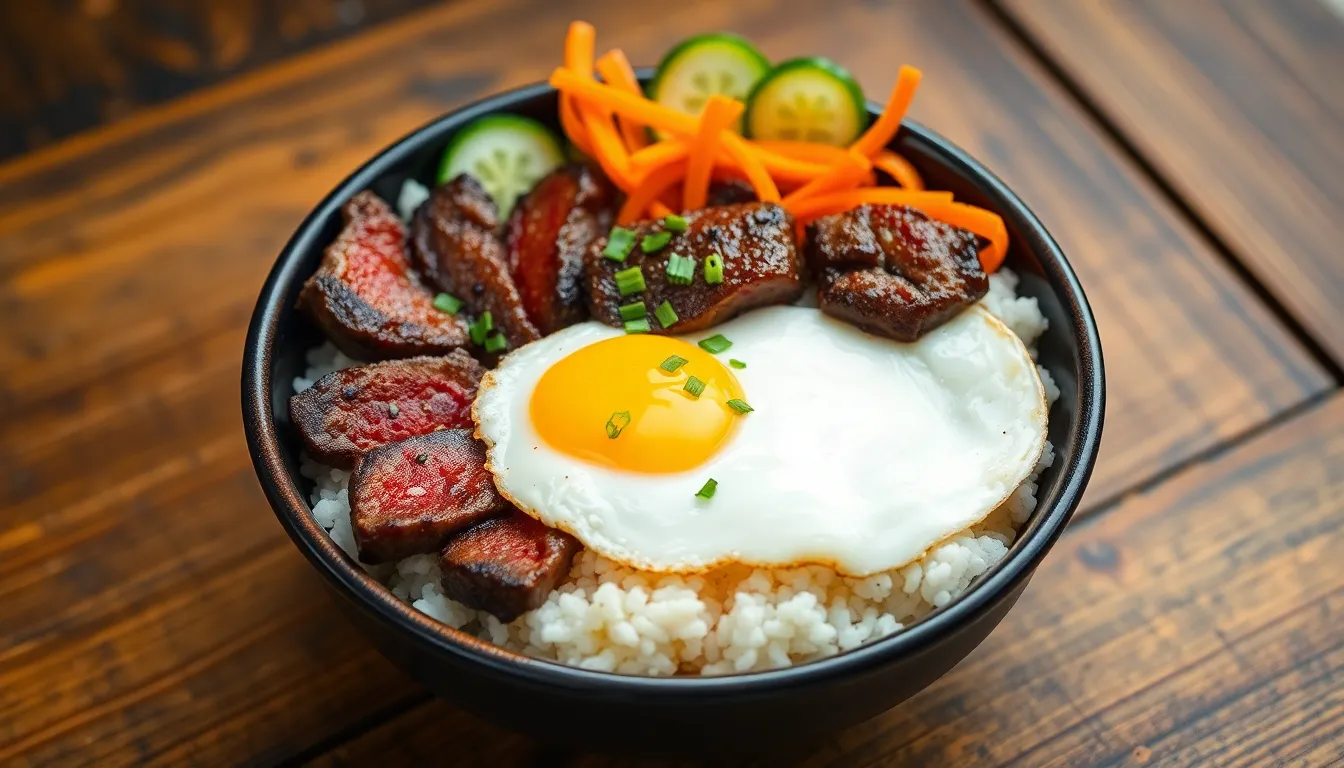
Follow these straightforward steps to create your authentic beef bulgogi bowl from start to finish. We’ll guide you through each stage to ensure perfectly balanced flavors and textures.
Prep the Marinade
Whisk together soy sauce, brown sugar, sesame oil, and chili garlic sauce in a large mixing bowl until the sugar completely dissolves. Add rice wine vinegar to brighten the mixture and balance the sweetness. Incorporate minced garlic and ginger for aromatic depth. Stir in thinly sliced shallots for subtle onion flavor and textural interest. The marinade should appear glossy and well combined.
Marinate the Beef
Add sliced ribeye or top sirloin to the prepared marinade and toss thoroughly to coat every piece. Ensure each slice gets complete coverage by massaging the marinade into the meat with clean hands. Cover the bowl tightly with plastic wrap or transfer to a sealed container. Refrigerate for at least 2 hours for optimal flavor absorption. For deeper taste penetration, marinate overnight.
Prepare the Pickled Vegetables
Slice cucumbers and carrots into thin julienne strips using a sharp knife or mandoline slicer. Combine equal parts rice vinegar and water in a bowl with a pinch of sugar and salt. Submerge the sliced vegetables in this pickling liquid for 2 to 3 hours at room temperature. The vegetables will become crisp and tangy while maintaining their fresh crunch.
Cook the Rice
Rinse rice under cold water until the water runs clear to remove excess starch. Combine rice with water in a heavy-bottomed pot using a 1:1.5 ratio. Bring to a boil over high heat then reduce to low heat and cover. Simmer for 18 minutes without lifting the lid. Remove from heat and let stand covered for 10 minutes before fluffing with a fork.
Cook the Bulgogi Beef
Heat vegetable oil in a large sauté pan over medium-high heat until shimmering. Remove beef from marinade and add to the hot pan in a single layer without overcrowding. Sear quickly for 2 to 3 minutes per side until caramelized and cooked through. Work in batches if necessary to maintain proper heat. The beef should develop deep brown edges while staying tender inside.
Assemble the Bulgogi Bowls
Divide warm cooked rice evenly among four serving bowls. Top each portion with the seared bulgogi beef while still hot. Add a fried egg to each bowl for richness and protein. Place kimchi and pickled vegetables alongside the beef for contrasting flavors and textures. Serve immediately while the beef remains warm and the egg yolk is runny.
Make-Ahead Instructions
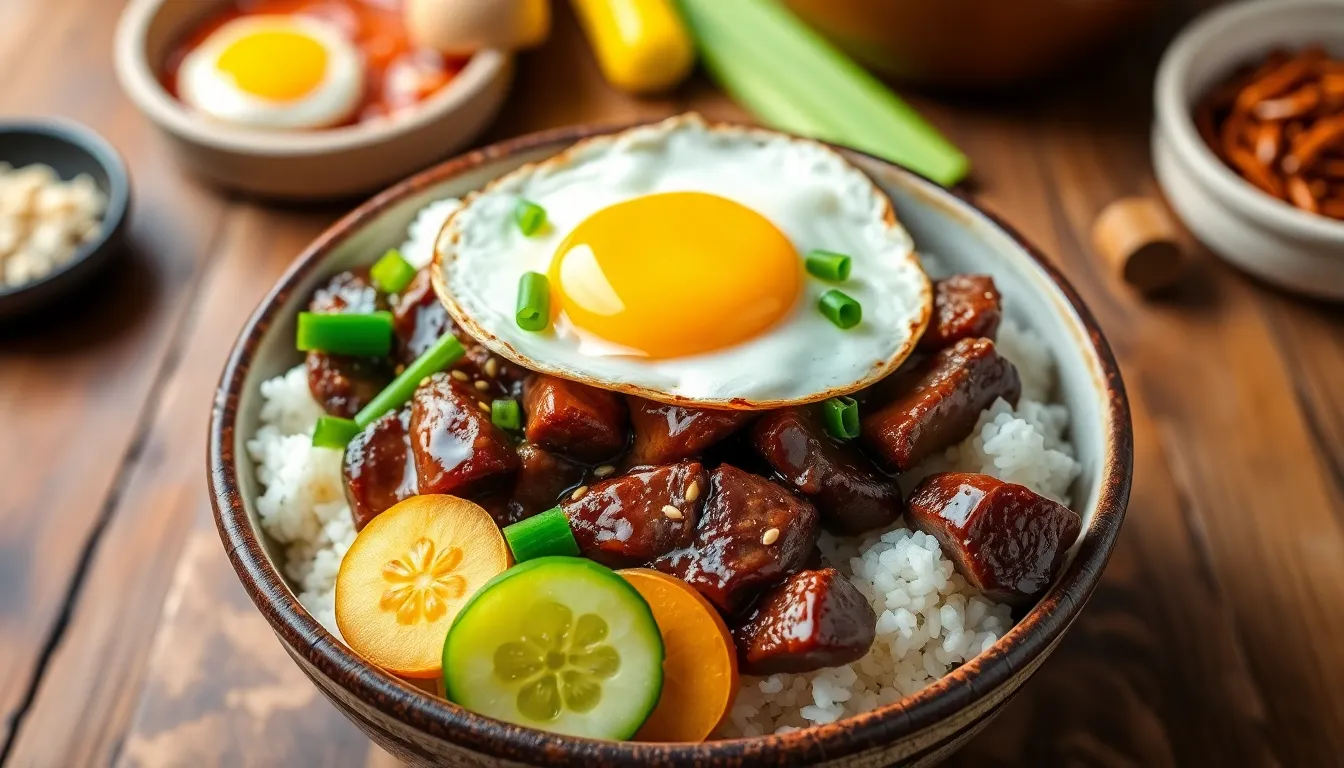
We designed this beef bulgogi bowl recipe with busy schedules in mind. The beauty of bulgogi lies in how well it responds to advance preparation techniques that actually enhance the final dish.
Marinating the Beef
Our beef benefits tremendously from extended marinating time. We recommend preparing the marinade and beef combination up to 24 hours before cooking. The longer marination period allows the soy sauce and brown sugar to penetrate deeper into the meat fibers while the garlic and ginger infuse their aromatic compounds throughout. Store the marinated beef in an airtight container in the refrigerator during this process.
Cooking Components Ahead
We can prepare the bulgogi beef completely and store it in the refrigerator for up to 3 days. After cooking the marinated beef according to our instructions, allow it to cool completely before transferring to storage containers. When ready to serve, gently reheat the beef in a skillet over medium heat until warmed through.
Rice Preparation
Our rice base can be cooked up to 2 days in advance. Store cooled rice in the refrigerator and reheat portions in the microwave with a splash of water to restore moisture. This technique ensures fluffy grains that won’t become mushy during reheating.
Vegetable Components
We can slice cucumbers into ribbons and store them in airtight containers for up to 2 days. The kimchi keeps well in the refrigerator for weeks when stored properly. These prepared vegetables maintain their crisp texture and bold flavors when prepped ahead.
Final Assembly Strategy
For the smoothest serving experience, we recommend frying eggs fresh just before assembly. The contrast between the warm runny yolk and the other components creates the ideal textural balance that makes this dish special. With all other components prepared in advance, final assembly takes just minutes.
Storage and Reheating Tips
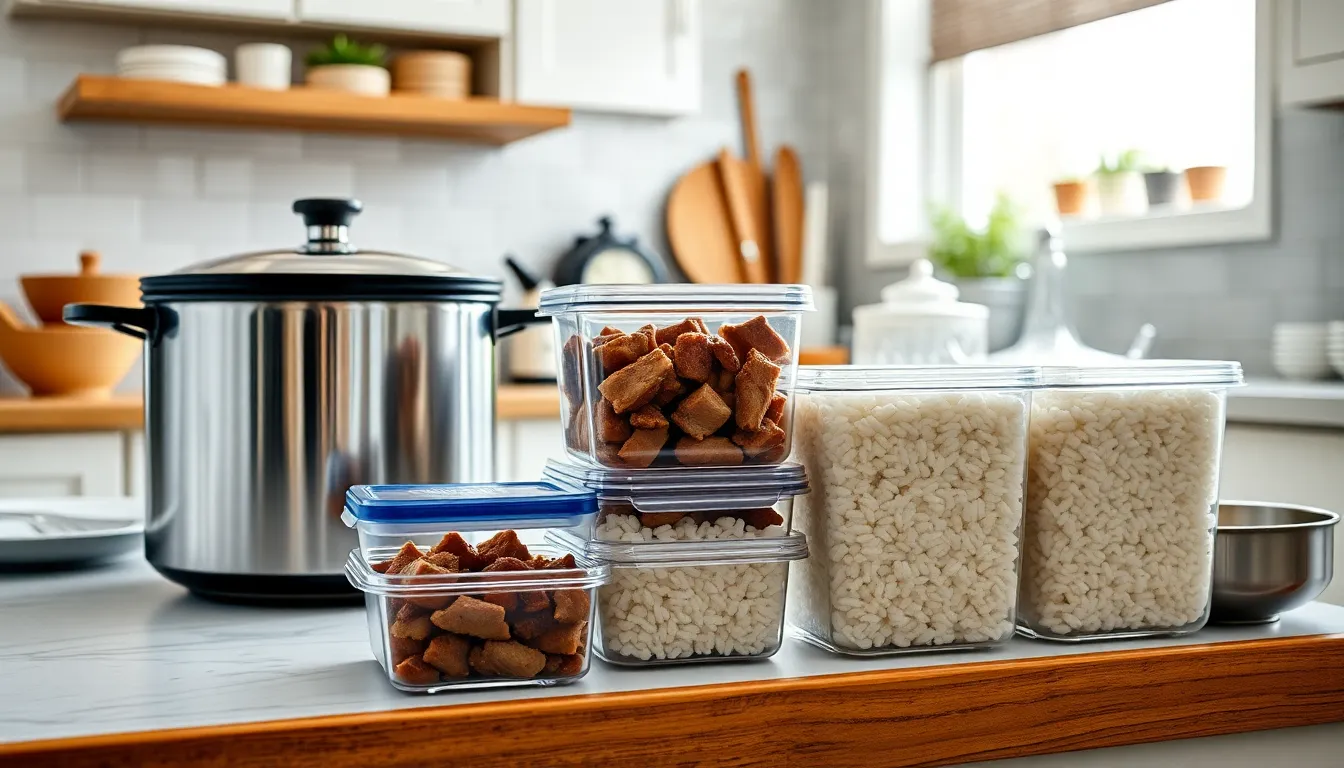
We recommend storing each component of your beef bulgogi bowl separately to maintain optimal texture and flavor. The cooked bulgogi beef should go into airtight containers and be refrigerated promptly after cooling to room temperature. Our experience shows that properly stored beef bulgogi maintains its quality for 3-4 days in the refrigerator.
Rice requires separate storage to prevent it from absorbing excess moisture from other ingredients. We suggest using sealed containers for the cooked rice, which will stay fresh for the same 3-4 day period when refrigerated properly.
Reheating the Bulgogi Beef
We prefer reheating bulgogi beef gently in a skillet over medium heat to preserve its tender texture. The meat can dry out quickly when overcooked, so we add a splash of water or a small amount of oil to maintain moisture during reheating. This method takes just 2-3 minutes and restores the beef’s original juiciness.
Reheating Rice and Other Components
Our recommended approach for rice involves steaming or microwaving with a damp paper towel covering the container. This technique prevents the grains from drying out and maintains their fluffy texture. We avoid reheating eggs since they become rubbery when warmed again. Fresh eggs cooked just before serving provide the best texture contrast with the other bowl components.
Freezing Options
We find that bulgogi freezes exceptionally well whether marinated but uncooked or after cooking. Portion the beef into meal-sized servings before freezing to make thawing more convenient. Frozen bulgogi maintains quality for up to 2 months when stored in freezer-safe containers.
| Storage Method | Duration | Best Practices |
|---|---|---|
| Refrigerated (cooked beef) | 3-4 days | Airtight containers, separate storage |
| Refrigerated (cooked rice) | 3-4 days | Sealed containers, avoid moisture |
| Frozen (marinated/cooked beef) | 2 months | Portion before freezing |
Thaw frozen bulgogi overnight in the refrigerator before reheating to ensure even warming throughout. We never recommend thawing at room temperature as this can compromise food safety and texture quality.
Serving Suggestions
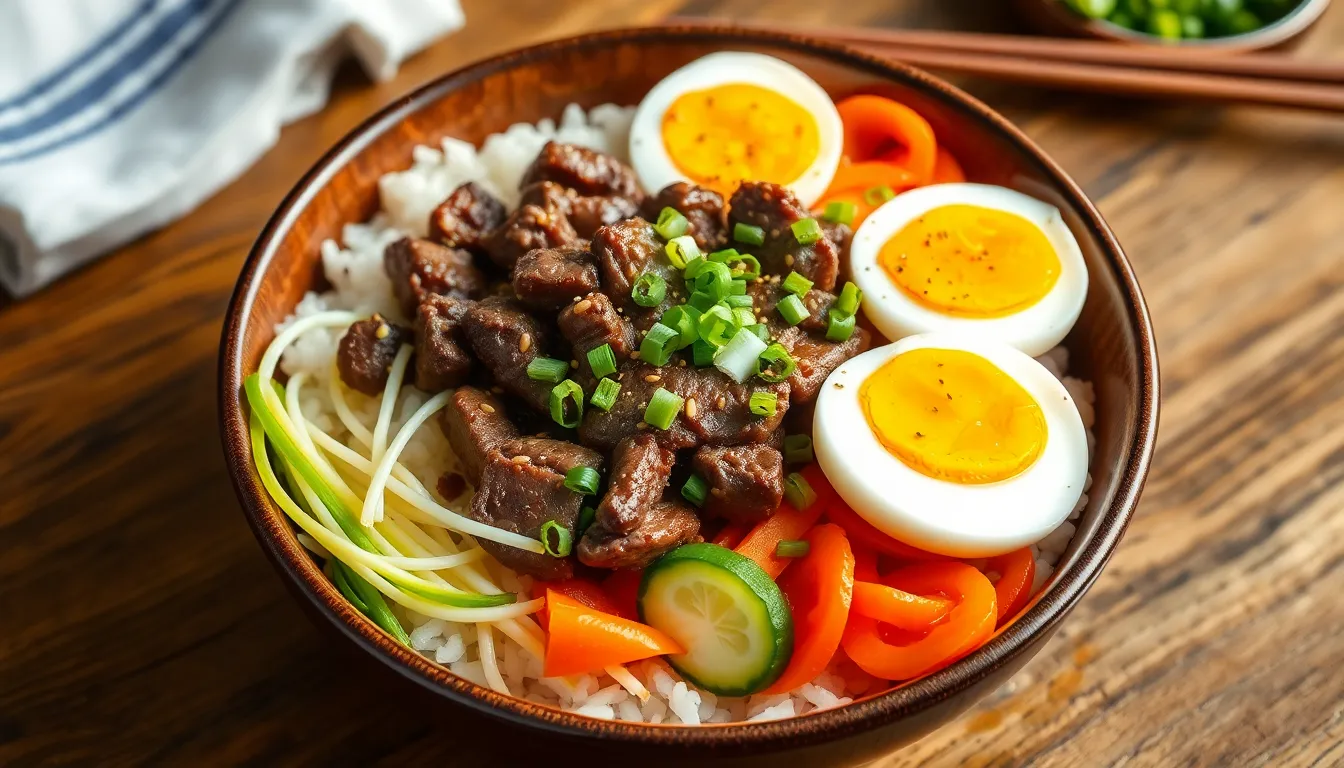
We recommend serving beef bulgogi bowls with sticky white rice as the traditional base. The tender grains absorb the savory-sweet marinade juices perfectly and create an authentic Korean dining experience. Quinoa or cauliflower rice work excellently as lighter alternatives for those seeking different nutritional profiles.
Fresh vegetable accompaniments elevate the bowl’s flavor complexity and textural contrast. We layer crisp mung bean sprouts alongside ribboned carrots and thinly sliced cucumbers for refreshing crunch. Shredded Napa cabbage or purple cabbage adds vibrant color while providing natural sweetness that balances the rich beef.
Kimchi serves as an essential fermented component that cuts through the bulgogi’s richness with its tangy heat. We place a generous portion alongside quick cucumber kimchi for those who prefer milder pickled flavors. The fermented vegetables aid digestion while adding probiotics to the meal.
Protein enhancements transform the bowl into a more substantial meal. Soft-boiled eggs with runny yolks create luxurious richness when mixed throughout the dish. We recommend cooking the eggs for exactly 6-7 minutes to achieve the perfect jammy texture that complements the tender beef.
Garnishing techniques maximize both visual appeal and flavor depth. Toasted sesame seeds provide nutty aroma and satisfying crunch when sprinkled generously over the assembled bowl. Sliced green onions add fresh bite and bright color contrast against the caramelized beef.
Sauce applications allow for customizable heat levels and additional flavor layers. We drizzle gochujang aioli or sriracha mayo in decorative patterns across the bowl for those who enjoy spicy elements. A squeeze of fresh lime juice brightens all the components while adding citrusy acidity.
Additional sides enhance the overall dining experience. Extra kimchi portions satisfy those who crave more fermented flavors. We often include small dishes of pickled radish or cucumber salad for palate cleansing between bites of the rich bulgogi.
Presentation styling creates restaurant-quality visual impact at home. We arrange components in distinct sections rather than mixing everything together, allowing diners to combine flavors according to their preferences. Avocado cubes add creamy richness and beautiful green color when placed strategically around the bowl’s perimeter.
Recipe Variations
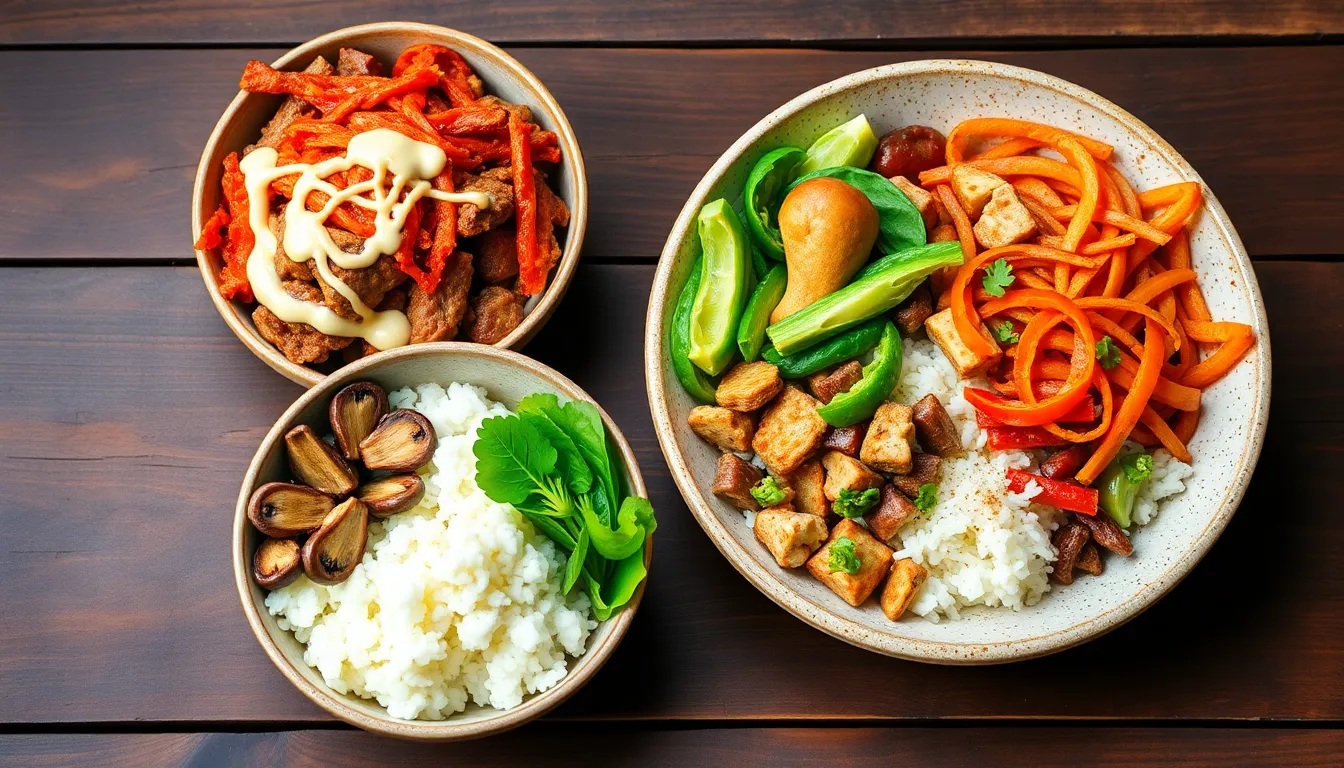
We love how adaptable bulgogi bowls are to different dietary preferences and spice tolerances. These three popular variations maintain the authentic Korean flavors while accommodating various nutritional needs.
Spicy Bulgogi Bowl
Our spicy bulgogi bowl transforms the traditional recipe by incorporating gochujang or chili garlic sauce directly into the marinade. We recommend starting with 1-2 tablespoons of gochujang for a moderate heat level that builds gradually. Spicy kimchi becomes the star vegetable topping instead of regular pickled vegetables.
The key to balancing the heat lies in our spicy mayo drizzle. We combine mayonnaise with sriracha and a touch of rice vinegar to create a creamy counterpoint to the fiery bulgogi. This cooling element prevents the spice from overwhelming the other flavors in the bowl.
For assembly we layer the spicy marinated beef over rice and top with fermented kimchi that adds both heat and beneficial probiotics. Green onions and sesame seeds provide fresh contrast to the bold spicy flavors throughout each bite.
Vegetarian Bulgogi Bowl
We create our vegetarian bulgogi using meaty mushrooms or plant-based ground “beef” that absorbs the traditional marinade beautifully. King oyster mushrooms work exceptionally well because their texture mimics beef when sliced and seared properly. The same soy sauce, brown sugar, sesame oil, and garlic marinade infuses these alternatives with authentic bulgogi flavors.
Preparation time remains under 30 minutes just like the original beef version. We sauté the mushrooms until golden and caramelized to develop deep umami flavors that satisfy even meat eaters. Carrots, cucumbers, and vegan kimchi provide the traditional vegetable components.
Our finishing touches include scallions and a generous drizzle of sesame oil to enhance the nutty flavors. This plant-based version delivers the same sweet-savory profile that makes bulgogi bowls so irresistible while meeting vegetarian dietary requirements.
Low-Carb Bulgogi Bowl
We replace traditional rice with cauliflower rice or a bed of mixed greens to dramatically reduce the carbohydrate content. This substitution cuts approximately 45 grams of carbs per serving while maintaining the satisfying bowl format. Lean cuts like sirloin or ground beef work perfectly with the bulgogi marinade for this variation.
Our vegetable selection focuses on non-starchy options including cabbage, cucumbers, and bell peppers that add crunch without excess carbs. We load these bowls generously with vegetables to ensure they remain filling and nutritious.
Avocado slices and sesame seeds provide healthy fats that help with satiety and nutrient absorption. The rich bulgogi flavors remain the focal point while the cauliflower rice absorbs the savory sauce just as effectively as regular rice would.
Conclusion
We’ve shared everything you need to create this incredible beef bulgogi bowl that’ll transform your weeknight dinners. This recipe delivers authentic Korean flavors with minimal effort and maximum satisfaction.
The beauty of this dish lies in its versatility – whether you’re meal prepping for the week or entertaining guests you can customize it to match any dietary preference. From spicy variations to low-carb alternatives there’s a bulgogi bowl for everyone.
With proper storage techniques and make-ahead tips you’ll always have restaurant-quality Korean comfort food ready in minutes. The combination of tender marinated beef perfectly seasoned rice and fresh vegetables creates a balanced meal that satisfies both your taste buds and nutritional needs.
Start marinating that beef tonight and discover why bulgogi bowls have become a favorite in kitchens worldwide.
Frequently Asked Questions
What is beef bulgogi?
Beef bulgogi is a popular Korean dish featuring tender, marinated beef that’s sweet, savory, and aromatic. The name “bulgogi” means “fire meat” in Korean. The beef is marinated in a mixture of soy sauce, brown sugar, sesame oil, garlic, and other seasonings, then quickly seared until caramelized. It’s traditionally served over rice with vegetables and pickled accompaniments.
How long should I marinate the bulgogi beef?
Marinate the bulgogi beef for at least 2 hours for good flavor absorption. For deeper, more intense flavors, marinate overnight or up to 24 hours in the refrigerator. The longer marination time allows the beef to fully absorb the sweet and savory marinade, resulting in more tender and flavorful meat.
What cut of beef works best for bulgogi?
Ribeye steak is the preferred cut for bulgogi due to its marbling and tenderness. Other suitable cuts include sirloin, tenderloin, or thinly sliced chuck roast. The key is to slice the beef very thinly against the grain, which helps ensure tenderness and allows the marinade to penetrate effectively.
Can I make bulgogi bowls ahead of time?
Yes, bulgogi bowls are excellent for meal prep. You can marinate the beef up to 24 hours in advance, cook the rice ahead of time, and prep vegetables. Store cooked bulgogi beef in the refrigerator for up to 3 days. For best results, fry eggs fresh just before serving and assemble bowls when ready to eat.
How do I store leftover bulgogi?
Store leftover bulgogi components separately in airtight containers in the refrigerator for 3-4 days. Cooked bulgogi beef can be frozen for up to 2 months. To reheat, warm the beef gently in a skillet with a splash of water or oil. Rice can be reheated in the microwave with a damp paper towel.
What vegetables go well with bulgogi bowls?
Traditional vegetables include spinach, carrots, shiitake mushrooms, mung bean sprouts, and cucumbers. Kimchi is essential for authentic flavor and adds tangy heat. You can also include pickled radish, ribboned carrots, and fresh greens. These vegetables provide texture contrast and help balance the rich, savory flavors of the bulgogi.
Can I make a vegetarian version of bulgogi?
Yes, you can create a vegetarian bulgogi bowl by substituting the beef with meaty mushrooms like king oyster or shiitake, or using plant-based ground “beef.” Use the same marinade and cooking technique. The mushrooms will absorb the flavors beautifully while providing a similar umami-rich taste and satisfying texture.
What’s the best rice for bulgogi bowls?
Short-grain sticky white rice is traditional and works best for bulgogi bowls because it holds together well and complements the savory flavors. For lighter alternatives, you can use quinoa, brown rice, or cauliflower rice for a low-carb option. Cook the rice until tender and slightly sticky for authentic texture.

